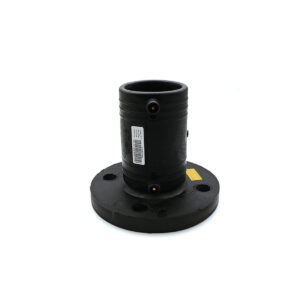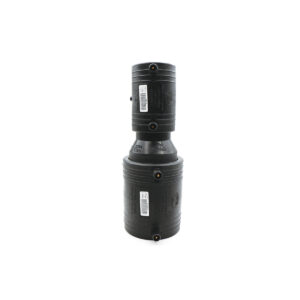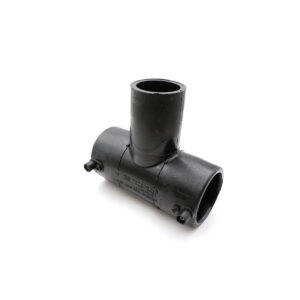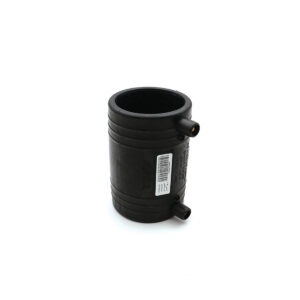Electrofusion fittings are one of the most advanced techniques for joining polymer pipes. By combining controlled electric current with localized heat, the pipe surface is melted so that a homogeneous, integral bond is created. In this process, the resistive coils inside the coupler generate heat as soon as current flows and simultaneously soften the polyethylene on both edges; upon cooling, a seamless, sealed joint is obtained whose mechanical and hydrostatic strength is on par with the pipe itself. This feature makes electrofusion the first choice for natural gas transmission networks, potable water distribution systems, gravity and pressurized sewer lines, and projects involving the extraction and injection of chemical fluids.
Fundamentals of Operation and Key Components
Coupler or fitting: A component made of PE100-grade polyethylene or higher, with a jacketed copper coil embedded within its wall.
Control Box: An intelligent power unit that delivers 8–48 V with constant or modulated current to the coupler while monitoring temperature, time, and circuit resistance.
Identification code or barcode: Printed on each fitting; the welding unit reads it to derive the optimal voltage and duration based on size, SDR, and ambient temperature.
Preparation tools: Mechanical scraper, groove gauge, isopropanol cleaner, and alignment clamps, ensuring no oxide, scratches, or misalignment prevents molecular bonding.
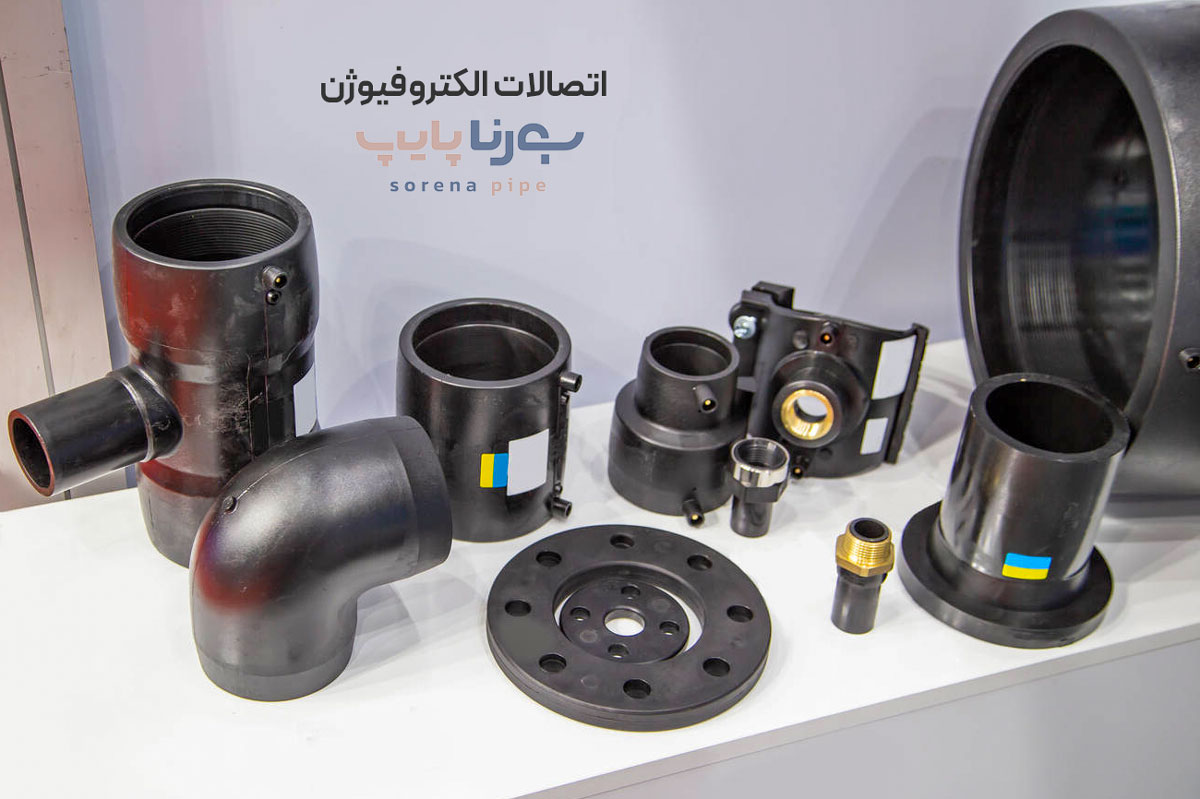
Step-by-Step Execution
Accurate cutting and beveling with a rotary cutter or guillotine; oblique cuts or crushed edges disrupt uniform heat distribution.
Surface scraping of both pipe ends to a depth of 0.2–0.4 mm to remove the oxide layer and contaminants.
Chemical cleaning with a lint-free cloth and 99% IPA; do not touch the scraped surface.
Insertion into the coupler and locking the clamps; the minimum insertion depth is indicated by the guideline on the fitting.
Connecting cables and scanning the barcode; the machine starts the welding cycle based on the barcode data.
Heating phase; the ohmic resistance of the coil transfers uniform heat to the annular zone and the two molten surfaces intermix.
Cooling under clamping; the pipe must not be moved until the temperature falls below 20 °C.
Visual inspection and pressure test; the raised polyethylene bead at both edges indicates full fusion. Then perform hydrostatic or pneumatic testing in accordance with ISO 1167 or EN 1359.
Advantages and Competitive Edge
100% sealing and a 50-year service life at pressures up to 16 bar.
No need for large flame generators and elimination of spark risk in explosive atmospheres.
Ability to join pipes of dissimilar diameters and shaped parts (elbow, tee, flange adapter).
High resistance to earthquakes, landslides, and uneven ground settlement.
Traceable weld data for project documentation (data logging).
Full compatibility with IGS, ASTM F1055, and DVS 2207 standards.
Table 1 – Comparison of Common Polyethylene Joining Methods
Feature/Method Electrofusion Butt Fusion Mechanical Coupler
Standard size range 20–630 mm 63–2000 mm 20–315 mm
Automatic quality control Yes (barcode) No No
Joining different diameters Yes with reducer No Limited
Field equipment Light & portable Heavy (hydraulic) Medium
Sensitivity to environment Low Medium Low
Cost at large sizes High Lower Medium
Design life ≥ 50 years ≥ 50 years 25–40 years
Types of Fittings and Scope of Use
Straight coupler: The most widely used type; suitable for repairing line breaks.
45° and 90° elbows: Managing direction changes in urban networks and petrochemical complexes.
Equal and reducing tees: Branching with negligible pressure loss.
Flange adapter and end cap: Connection to metal valves, tanks, or terminal blocking.
Concentric reducer: Diameter change to bypass structural obstacles or balance flow rate.
Table 2 – Pressure/Size Classes for PE100 Couplers
Size (mm) SDR11 (PN16) SDR17 (PN10)
20–125 ✔ ✔
140–250 ✔ ✔
280–400 ✔ —
450–630 — ✔
A “✔” indicates commercial production and typical market availability.
Quality Control and Non-Destructive Testing
NDT methods such as circumferential phased-array ultrasonic testing (PAUT), wireless ring-resistance measurement, and stepwise pressure testing with tracer-gas leak detection have replaced destructive cutting. Using these technologies not only increases operational reliability but also reduces the cost and outage time of the network. In sour-gas transmission projects, FTIR-based molecular displacement assessment is performed to ensure absence of H₂S-induced embrittlement.
Critical Parameters for Welding Success
Adjust voltage to ambient temperature; each 10 °C drop increases weld time by about 10%.
Maximum allowable pipe ovality before scraping ≤ 1.5% of nominal diameter.
Workshop relative humidity below 80%; water vapor can create internal bubbles.
Material compatibility; combining PE80 with PE100 is not permitted unless the fitting has a transitional layer.
Interfacial gap less than 0.2 mm; stabilization clamps must remain closed until cooling is complete.
Environmental Challenges and Waste Management
The metal heating element inside the coupler makes full recycling of the fitting difficult; authorized recyclers usually first separate the metal by induction methods and then use the purified polyethylene to produce non-critical pipes (such as cable sheathing). Optimizing element design and reducing copper mass are the main pathways to lowering the carbon footprint of the new generation of couplers. Research is also underway on bio-electropolymers combining PLA/PE to enable partial compostability.
The Future of Electrofusion Technology
RFID smart couplers: Automatic logging of project ID, GPS position, and an embedded data logger for lifetime traceability.
Kinetic-energy systems: Recovering wasted coupler heat and converting it to electricity to power pressure sensors.
In-network installation robots: Performing scraping, cleaning, and welding from inside the pipe—especially in large urban diameters—without extensive excavation.
PE100-RC nanocomposite materials: Higher resistance to slow crack growth and reduced wall thickness, meaning faster, lighter joints.
Key Notes for Selection and Purchase
Certificate credibility: Ensure the fitting bears an ISO 9001 quality mark and a type-test certificate per EN 1555 or EN 12201.
Barcode fidelity: Clear laser-printed barcode with serial number ensures product traceability.
UV-proof double-layer packaging: Direct sunlight degrades polymer chains and shortens service life.
Manufacturer technical support: Availability of software to calculate weld time based on ambient temperature and pipe diameter reduces operator error risk.
SDR matching of fitting and pipe: A mismatch greater than one SDR class concentrates stress at the joint.
Tamam Baha — Your Trusted Electrofusion Partner
As a recognized supplier of electrofusion fittings, Tamam Baha offers a complete range of PE100 couplers, elbows, and tees from 20 to 400 mm with certificates of authenticity. For contractors, industrial users, and utilities across Europe and the Middle East, our experienced engineering team provides technical support and practical training so your fluid-transfer projects achieve the highest operational reliability.

